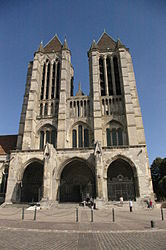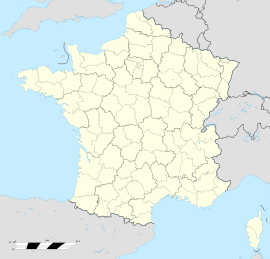- Noyon
-
Noyon
Western facade of the Cathedral of Noyon Administration Country France Region Picardy Department Oise Arrondissement Compiègne Canton Noyon Intercommunality Pays Noyonnais Mayor Pierre Vaurs
(2001–2008)Statistics Elevation 36–153 m (118–502 ft)
(avg. 52 m/171 ft)Land area1 18.00 km2 (6.95 sq mi) Population2 14,471 (1999) - Density 804 /km2 (2,080 /sq mi) INSEE/Postal code 60471/ 60400 1 French Land Register data, which excludes lakes, ponds, glaciers > 1 km² (0.386 sq mi or 247 acres) and river estuaries. 2 Population without double counting: residents of multiple communes (e.g., students and military personnel) only counted once. Coordinates: 49°34′54″N 2°59′59″E / 49.5816666667°N 2.99972222222°E
Noyon (Latin: Noviomagus Veromanduorum) is a commune in the Oise department in northern France.
It lies on the Oise Canal, 100 km (approximately 60 miles) north of Paris.
Contents
History
The Gallo-Romans founded the town as Noviomagus. Supposedly also known as Veromanduorum to distinguish it from numerous other places of the same name, though no Roman source can prove it.[1] The town is mentioned in the Antonine Itinerary as being 27 M.P. from Soissons, and 34 M.P. from Amiens. But their distances are not exact, as the 18th-century geographer Jean Baptiste Bourguignon d'Anville remarks, for Noyon is further from Amiens and nearer to Soissons than the itinerary says. The mutation of the name Noviomagus to Noyon is made clearer in Medieval Latin documents, where the town is then called Noviomum.
Noyon was strongly fortified; some sections of the Roman walls still remained in late antiquity. This may explain why, around the year 531, bishop Medardus moved his seat from Vermand, in the Vermandois, to Noyon. Other explanations are that Medardus was born near the town, at Salency, or that the place is nearer to Soissons, which was one of the royal capitals of the Merovingians. The bishop of Noyon was also bishop of Tournai from the seventh century until Tournai was raised to a separate diocese 1146.[2]
The cathedral at Noyon was where the first Holy Roman Emperor Charlemagne was crowned in 768, as too was the first Capetian king, Hugh Capet in 987. The town received a communal charter in 1108, which was later confirmed by Philip Augustus in 1223. In the twelfth century, the diocese of Noyon was raised to an ecclesiastical duchy in the peerage of France. The Romanesque cathedral was destroyed by fire in 1131, but soon replaced by the present cathedral, Notre-Dame de Noyon, constructed between 1145 and 1235, one of the earliest examples of Gothic architecture in France. The bishop's library is a historic example of half-timbered construction.
By the Treaty of Noyon, signed on the 13 August 1516 between Francis I of France and emperor Charles V, France abandoned its claims to the Kingdom of Naples and received the Duchy of Milan in recompense. The treaty brought the War of the League of Cambrai— one stage of the Italian Wars— to a close. Having been ravaged by Habsburg troops in 1552, Noyon was sold to France in 1559, under the conditions of the Treaty of Cateau-Cambrésis. Near the end of the sixteenth century the town fell under Habsburg control, but Henry IV of France recaptured it. The Concordat of 1801 suppressed its bishopric. The town was occupied by the Germans during World War I and World War II and on both occasions suffered heavy damage.
Notable people
- John Calvin was born in Noyon, 1509.
- Medardus
- Godeberta
- Jacques de Noyon
Twin towns
Noyon is twinned with
See also
References
- INSEE commune file
 This article incorporates text from a publication now in the public domain: Smith, William, ed (1854–57). "article name needed". Dictionary of Greek and Roman Geography. London: John Murray.
This article incorporates text from a publication now in the public domain: Smith, William, ed (1854–57). "article name needed". Dictionary of Greek and Roman Geography. London: John Murray.
- ^ The place-name is Celtic, combination of two well-known place-name elements : magos ("field, plain or market") and noviios ("new"), so : New field / market of the Veromandui".
- ^ Catholic Encyclopedia, s.v. Tournai [Doornik] (Diocese); Roman Catholic Diocese of Tournai.
External links
About the cathedral:
Categories:- Communes of Oise
- Roman towns and cities in France
Wikimedia Foundation. 2010.


